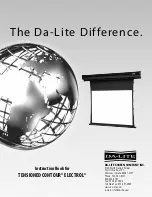
This document provides safety instructions and describes the specifications. Read this document carefully before
use to ensure your safety and product performance.
Data transmission is always initiated by software, which is the passed down through the MAC, through the digital
and analog baseband, and finally to the RF chip. Several special packets are initiated by the MAC. These are the
only ways the digital baseband portion will turn on the RF transmitter, which it then turns off at the end of the
packet. Therefore, the transmitter will be on only while one of the aforementioned packets is being transmitted. In
other words, this device automatically discontinues transmission in case of either absence of information to
transmit or operational failure.
This equipment is restricted to indoor operation only.
U.S. FCC Notices
This device complies with Part 15 of the FCC Rules. Operation is subject to the following two conditions: (1) This
device may not cause harmful interference, and (2) this device must accept any interference received, including
interference that may cause undesired operation.
This equipment has been tested and found to comply with the limits for a Class B digital device, pursuant to Part
15 of the FCC Rules. These limits are designed to provide reasonable protection against harmful interference in a
residential installation. This equipment generates, uses and can radiate radio frequency energy and, if not installed
and used in accordance with the instructions, may cause harmful interference to radio communications.
However, there is no guarantee that interference will not occur in a particular installation. If this equipment does
cause harmful interference to radio or television reception, which can be determined by turning the equipment off
and on, the user is encouraged to try to correct the interference by one of the following measures:
■
Reorient or relocate the receiving antenna.
■
Increase the separation between the equipment and receiver.
■
Connect the equipment into an outlet on a circuit different from that to which the receiver is connected.
■
Consult the dealer or an experienced radio/TV technician for help.
Caution: Changes or modifications not expressly approved by the party responsible for compliance could void the
user’s authority to operate this equipment. Properly shielded and grounded cables and connectors must be used for
connection to host computers and/or peripherals in order to meet FCC emission limits.
This transmitter must not be co-located or operating in conjunction with any other antenna or transmitter.
This equipment complies with FCC radiation exposure limits set forth for an uncontrolled environment and meets
the FCC radio frequency (RF) Exposure Guidelines. This equipment should be installed and operated keeping the
radiator at least 7.8 inches (20 cm) or more away from person’s body
Industry Canada (IC) Notices
CAN ICES-3(B)/NMB-3(B)
This device complies with Industry Canada’s license-exempt RSSs. Operation is subject to the following two
conditions: (1) This device may not cause harmful interference, and (2) this device must accept any interference,
including interference that may cause undesired operation.
This equipment complies with IC radiation exposure limits set forth for an uncontrolled environment and meets
RSS-102 of the IC radio frequency (RF) Exposure rules. This equipment should be installed and operated keeping
the radiator at least 7.8 inches (20 cm) or more away from person’s body.
EN
Summary of Contents for WN8111BEP
Page 1: ...Wireless LAN Unit WN8111BEP User s Guide Guide de l utilisateur ...
Page 4: ...146 EN ...
Page 10: ...146 FR ...































